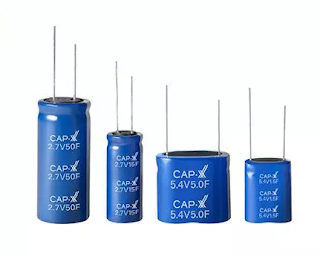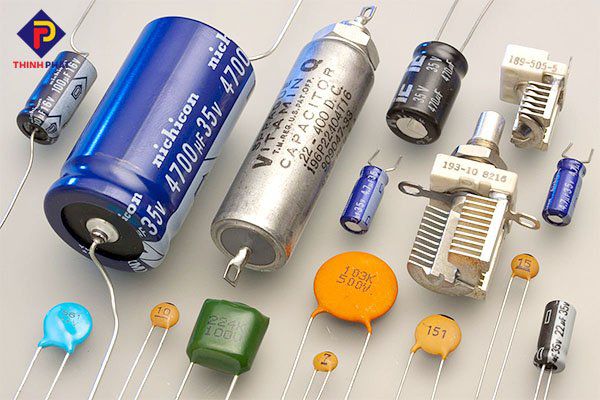Common types of capacitors
Capacitors are quite familiar electronic components, we can see capacitors in most types of electronic circuits today. They are used and app...
Capacitors are quite familiar electronic components, we can see capacitors in most types of electronic circuits today. They are used and applied a lot in the electronics manufacturing and manufacturing industries. The following article will give you full information about this type of component, including what is a capacitor? Structure of a capacitor? What are the common types of capacitors?
1. What is capacitor?
Capacitors are a type of passive electronic component formed by two conductive surfaces separated by a dielectric. When there is a potential difference at the two surfaces, these surfaces will appear charged with the same but opposite sign.
The accumulation of charges on the two surfaces creates the capacitor's ability to store electric field energy. When the potential difference across the two surfaces is an AC potential, the charge accumulation is behind in phase with the voltage, creating the impedance of the capacitor in the AC circuit.
Capacitors are one of the most important components of electronic equipment. It is an indispensable component in filter circuits, oscillator circuits and AC signal transmission circuits.
To ensure that the electrical conductors connected to the capacitor are operated efficiently and stably, without causing loss of beauty, when constructing electromechanical systems, people often use 200x100 cable trays, electrolytic cable trays and accessories. cable tray.
2. Structure of the capacitor
The structure of a common capacitor is as follows: Consists of at least two electrical conductors, usually in the form of metal plates. These two surfaces are placed parallel to each other and separated by a dielectric layer.
 |
| Structure of the capacitor |
Substances used as dielectrics for capacitors are non-conductive substances including: glass, impregnated paper, paper, mica, plastic film or air. These substances are not capable of conducting electricity for the purpose of increasing the ability of the capacitor to store electrical energy.
Capacitors will have the appropriate name depending on the insulating material in the center of the plate. For example, the insulating layer is air, it is called an air capacitor, is called a paper capacitor, or ceramic has a ceramic capacitor.
The conductors connected to the capacitor will be placed in the electrolytic galvanized cable tray to protect the electrical system and bring safety; save space, increase aesthetics; Easy to install and repair.
3. Working principle of capacitor
The charging principle of a capacitor is the ability to store electrical energy like a small battery in the form of electric field energy. It efficiently stores electrons and releases these charges to generate an electric current. However, it is not capable of generating electron charges. This is also considered the biggest difference between a capacitor and a battery.
The principle of charging and discharging of the capacitor is a characteristic property and is also the basic thing in the working principle of this device. Based on that property, the capacitor is capable of conducting alternating current.
In case the voltage of the two circuits works normally, does not change suddenly but varies with time, when we plug in or discharge the capacitor, it is very likely to cause an explosion with sparks due to the surge of current. . This is considered the common principle of capacitors.
4. Common types of capacitors
4.1 Capacitor (Polarized Capacitor)
This is a type of capacitor with polarity, so when using it, it is necessary to plug in the correct pin of the capacitor with the supply voltage. Usually, on the capacitors will instruct the user with the symbols (+) or (-) corresponding to the capacitor pins.
Capacitors have two forms:
- Capacitor has legs at the two ends of the round cylinder of the capacitor
- Capacitor has two legs connected to the same round cylinder head
The capacitor body will usually be listed with the maximum voltage value that the capacitor can withstand. If the voltage level is higher than the voltage on the capacitor, the capacitor will likely swell or explode. The value of the capacitor is written directly on the body, for example 10µF, 100µF, etc.
Capacitors are often used as filtering devices in power supplies to reduce voltage noise. In addition, the condenser is also used to smooth the input and output signals, and can be used as a low-pass filter if the signal is a DC signal.
When installed, the capacitor will be wired to get to the place where it needs to be used. In order for the wiring to work at its best, it is necessary to use a powder-coated cable tray. This system will help to support and guide the entire electrical conductor.
4.2. Non-polar capacitors (Paper capacitors, ceramic capacitors, mica capacitors)
This type of capacitor does not specify positive or negative polarity, is a small, flat-shaped capacitor and usually has a small capacitance of 0.47µF or less.
Non-polar capacitors can be replaced by polarized capacitors and can be freely installed without regard to the polarity of the capacitor.
This type of capacitor is used in high working frequency circuits, as noise filter circuits and in civil equipment such as pump capacitors, motor capacitors, grid phase compensation capacitors, etc.
4.3. Rotating Capacitor (Variable Capacitor)
This type of capacitor can be rotated to change the capacitance value. This capacitor will normally be installed in the radio to change the resonant frequency when performing radio tuning.
Capacitors have very small values, only from 100pF to 500pF.
4.4. Super Capacitor
Supercapacitors are capacitors with super high energy density (supercapacitors) such as Li ion capacitors (also known as LIC capacitors).
 |
| Super Capacitor |
This type of capacitor is capable of storing electricity for several months, providing power instead of data storage batteries in electronic machines. They have the ability to quickly charge up and store a lot of energy, are applied in traffic to re-exploit braking (brake) energy, providing sudden peak power for electric cars, trams, fast trains.
>>>> Types of capacitors available in the market: Capacitor
Application of the capacitor
- The first application of capacitors is the ability to store electrical energy, effectively storing electrical charge. Capacitors have the same storage function as batteries, but their advantage is storage without consuming electrical energy.
Capacitors allow AC voltage to pass through, making the capacitor conductive like a general-purpose resistor.
- Because of the principle of operation is the ability to intelligently charge and discharge, prevent DC voltage, the capacitor can allow alternating voltage to circulate to help transmit signals between amplifier stages with potential difference.
Capacitors can filter AC voltage to flat DC voltage by removing negative phase. Learn more: Sine wave generator circuit
Suggested related content:
The electrical, radiant energy throughout the universe, which Tesla referred to and would use to provide power wirelessly of all the inventions and discoveries of Nikola Tesla, stood out with greater potential benefit to the whole of humanity and his discovery of Radiant Energy. Only after conducting exhaustive experimental trials for three years, did Tesla announce this discovery in a paper published in December, 1892, entitled "The Dissipation of Electricity" .
Radiant Energy is always there in our atmosphere. Radiant energy includes solar radiation from the sun, as well as cosmic rays from the stars. New and varied free energy devices harness this power to produce electricity
Electronic Circuit for Radiant Energy: Radiant Energy with Bifilar coil - Impulse Technology
Electronic equipment required for radiant energy: Electronic components for Radiant Energy - Impulse Technology
Tesla gives various options for the switching device. One is a rotary switch that resembles a Tesla circuit controller. Another is an electrostatic device consisting of two very light, membranous conductors suspended in a vacuum. These sense the energy build-up in the capacitor, one going positive, the other negative, and, at a certain charge level, are attracted, touch, and thus fire the capacitor. Tesla also mentions another switching device consisting of a minute air gap or weak dielectric film which breaks down suddenly when a certain potential is reached.
Copyright by:
Name: Moray Generator
Address: Beeghley Street City, State, Zip: Waco, Texas(TX), 76701
Phone number: 254-845-8642
Social networks:
Fb: https://www.facebook.com/Moray-Generator-104174915423201
Youtube: https://www.youtube.com/channel/UCk1HMjhYZcuTisdnpupirVQ
Bountysource: https://www.bountysource.com/teams/moray-generator/updates/2-pulse-generator-and-radiant-energy




